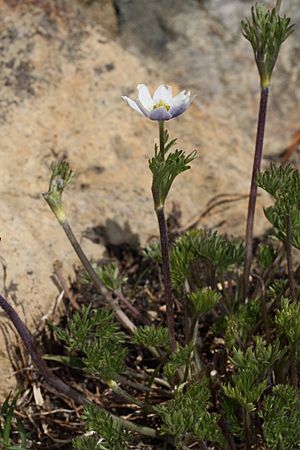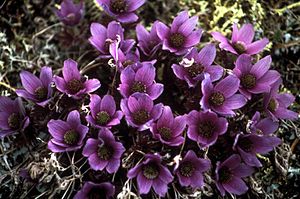Drummond's anemone facts for kids
Quick facts for kids Drummond's anemone |
|
|---|---|
 |
|
| Wenatchee Mountains | |
| Scientific classification | |
| Genus: |
Anemone
|
| Species: |
drummondii
|
Anemone drummondii, also known as Drummond's anemone, is a beautiful wild flower. It grows in the western parts of North America, from California all the way up to Alaska. This plant is a perennial, which means it lives for more than two years. It has short stems and soft, wrinkled leaves.
Contents
About Drummond's Anemone
What Does It Look Like?
Each Drummond's anemone plant grows in a clump and produces several eye-catching flowers. These flowers have five to eight parts that look like petals, but they are actually called sepals. The sepals are usually white, but they often have a clear blue tint. The center of the flower is full of many yellow stamens. These stamens are the parts of the flower that produce pollen.
Where Does It Grow?
Drummond's anemone is a plant that loves mountainous areas. You can find it in places like the Cascade Range and the Sierra Nevada. It grows in different environments, from coniferous forests (which have cone-bearing trees like pines) up to very high alpine elevations. Alpine areas are cold, treeless regions found on mountains, similar to the climate above the tree line.
How Does It Reproduce?
After the flowers bloom, the plant produces fruits. These fruits are called achenes. Achenes are small, dry fruits that contain a single seed. The achenes of Drummond's anemone are described as "woolly," meaning they have a soft, fuzzy covering. This covering might help the seeds spread, perhaps by catching the wind or sticking to animals.
See also
 In Spanish: Anemone drummondii para niños
In Spanish: Anemone drummondii para niños


